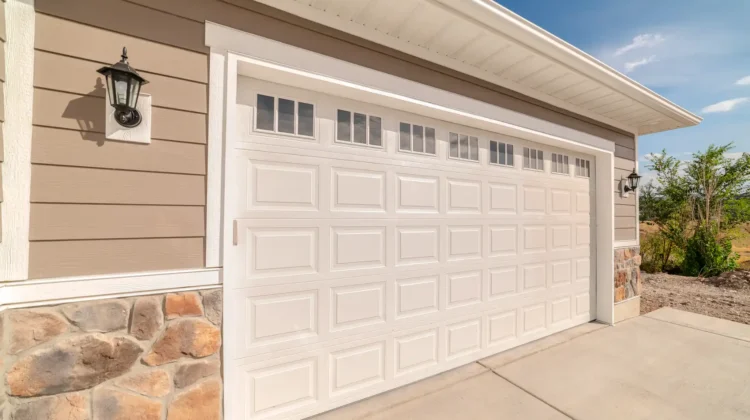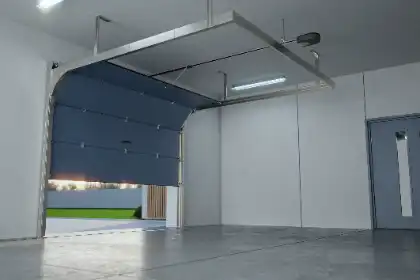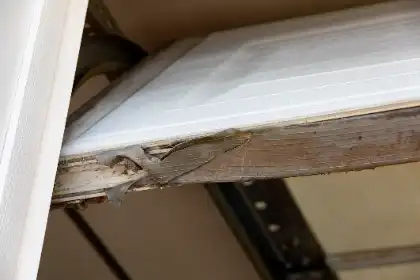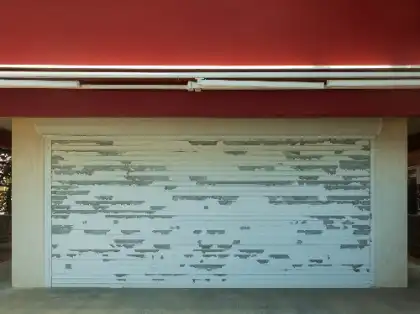
Homeowners often face a common dilemma: When to Replace vs. Repair Your Garage Door? Deciding between garage door replacement and garage door repair can be challenging. This decision is crucial not only for the functionality of your home but also for its curb appeal and safety.
A well-maintained garage door significantly contributes to the overall aesthetic of your home and ensures the security of your property. An outdated or malfunctioning door, on the other hand, can pose safety risks and detract from your home’s visual appeal.
In this article, you will learn:
- The typical lifespan of garage doors and factors influencing their longevity.
- Key indicators that suggest replacement over repair.
- Common issues that can be resolved with repairs.
- A cost comparison between repairing and replacing.
- Additional considerations impacting your decision.
- Material options available for new garage doors.
- How to create a comprehensive homeowner’s checklist to guide your decision-making process.
By the end of this blog, you will be better equipped to make an informed choice about whether to repair or replace your garage door based on your specific circumstances.
Understanding Garage Door Lifespan and Usage

The garage door lifespan can range between 15 to 30 years, influenced by various factors. One key determinant is usage frequency. Doors subjected to frequent opening and closing cycles experience more wear and tear, potentially shortening their lifespan. On average, American garage doors are operated about 1,500 times per year, which adds up over time.
Weather exposure also plays a significant role in determining how long your garage door lasts.
For instance:
- Extreme temperatures can cause materials to expand and contract, leading to cracks or warping.
- Moisture from rain or snow can lead to rust in metal doors or rot in wooden ones.
The quality of the installation process is another critical factor. A poorly installed door may not function correctly, leading to increased strain on components and a shorter life expectancy.
Regular inspections are essential for maintaining the longevity of your garage door. By identifying potential issues early on, you can address minor problems before they escalate into major repairs or necessitate a full replacement. Key areas to inspect include:
- Pulleys
- Cables
- Balance
- Tracks
- Rollers
- Hardware
Consistent maintenance helps in extending the lifespan of your garage door and ensures it remains functional and safe for daily use.
Key Indicators for Replacing Your Garage Door

Knowing when to replace your garage door can help you avoid unexpected breakdowns and expensive repairs.
Here are some key signs to look out for:
Lack of Modern Safety Features
If your garage door doesn’t have modern safety features like child safety mechanisms or auto-reverse functionalities, it may be time to consider an upgrade. These features are essential for preventing accidents and ensuring the safety of everyone in your household.
Age-Related Wear
Garage doors usually last between 15 to 30 years. If your door is older and showing signs of wear that affect its functionality and appearance, it might be time for a replacement.
Keep an eye out for:
- Significant weather damage: Harsh weather conditions can cause warping, cracking, or rust.
- Long-term structural issues: Problems like sagging, imbalance, or difficulty in operation may indicate deeper structural damage.
Compromised Security and Energy Efficiency
Weather exposure and poor maintenance can worsen these issues, leading to compromised security and energy inefficiency. A damaged door not only decreases the attractiveness of your home but also poses risks by potentially allowing pests inside and increasing heating/cooling costs due to poor insulation. To combat this, you might want to consider improving your home’s insulation, which can significantly enhance energy efficiency.
4. Cost-Effectiveness of Replacement
In some cases, replacing a damaged door is more cost-effective than repairing multiple panels or fixing severe mechanical failures. If you’re facing any of these problems, it may be worth exploring new garage door options that offer better durability, security, and aesthetics.
When Repairing Your Garage Door Makes Sense

Knowing when to repair your garage door instead of replacing it can save you time and money. Many common problems can be fixed without having to replace the entire door, making repairs a practical choice in many situations.
Common Minor Issues:
- Sagging Door
- Often caused by balance issues, a sagging door can typically be corrected by adjusting the tension of the springs or the alignment of the tracks.
- Mechanical Failures
- Problems such as motor malfunctions, broken belts or chains, and spring failures are usually fixable by replacing the faulty components.
- Cosmetic Damage
- Dents, chipped paint, or minor surface damage do not generally affect the functionality of your garage door. These issues can often be addressed with simple touch-ups or panel replacements.
- Worn-Out Hardware
- Replacing worn-out rollers, hinges, or cables can restore your garage door’s smooth operation without significant expense. Regular maintenance checks help identify these issues early on.
- Sensor Alignment:
- Misaligned sensors can cause operational problems, but are quick fixes that involve realigning or cleaning the sensors to ensure they function correctly.
In situations where budget constraints are a concern, opting for repairs over replacement may be more feasible. Addressing these minor issues promptly helps maintain your garage door’s performance and extends its lifespan, ensuring it remains reliable and safe to use.
Cost Comparison: Repair vs. Replacement
Understanding the financial aspect of maintaining your garage door is critical for making an informed decision. The garage door repair cost typically ranges from $150 to $500 for common issues such as spring replacements, cable repairs, or fixing minor dents and hardware. Severe repairs—including multiple component failures or significant structural fixes—can push costs up to $1,700, especially if professional labor is required.
The garage door replacement cost varies significantly based on material, insulation level, design, and any custom features you select:
- Basic steel or aluminum doors: $700–$1,200 (including installation)
- Insulated or composite models: $1,200–$2,500
- High-end wood or custom carriage house doors: $2,500–$4,500+
Several factors influence both repair and replacement pricing:
- Door size and material: Heavier or specialty materials often come with higher costs.
- Labor rates in your area: Local market rates can fluctuate widely.
- Extent of damage: Multiple panels or system components may require a larger investment.
- Feature upgrades: Modern safety sensors, smart openers, or enhanced insulation will add to the total.
Requesting quotes from local garage door specialists helps you compare real-time figures for both repair and replacement options. Factoring in the age and condition of your current door helps clarify which investment delivers better value for your home.
Additional Considerations Impacting Your Decision
Garage door security risks and energy efficiency often tip the scales when weighing repair against replacement. Security stands out as a major concern for most homeowners. Older garage doors may lack robust locking mechanisms or can be easier targets for forced entry, exposing your home to unnecessary risk. Newer models frequently incorporate reinforced panels, smart locks, and rolling code technology that makes unauthorized access much more difficult.
Energy-efficient garage doors also play a significant role in long-term savings. Insulated doors help stabilize temperatures in your garage, reducing the workload on heating and cooling systems—especially important if your garage is attached to the house or used as a workspace. Upgrading to a door with advanced insulation or weather sealing directly impacts utility bills and indoor comfort.
Other factors to keep in mind:
- Noise Reduction: Modern doors typically offer quieter operation due to improved hardware and materials.
- Pest Prevention: Damaged or warped doors create gaps that invite rodents and insects inside.
- Resale Value: A high-quality, aesthetically pleasing door can boost curb appeal and increase your property’s market value.
Each of these considerations ties back to safety, comfort, and the long-term value you derive from your investment.
Replacement Material Options and Their Benefits
When considering a new garage door, understanding the available materials is crucial. Each material offers distinct advantages and potential drawbacks, impacting durability, aesthetics, and energy efficiency.
Steel/Aluminum
- Durability: Highly durable with rust prevention coatings.
- Aesthetics: Available in various finishes and styles to match your home.
- Insulation: Often includes insulation options to improve energy efficiency.
Glass-and-Aluminum
- Durability: Sturdy aluminum frames with tempered glass panels.
- Aesthetics: Modern look that allows natural light into the garage.
- Insulation: Generally less insulating compared to other materials.
Composite Materials
- Durability: Combines steel interiors with wood finishes for enhanced strength.
- Aesthetics: Mimics the appearance of real wood without the maintenance requirements.
- Insulation: Good insulation properties due to layered construction.
Wood
- Durability: Requires regular maintenance to prevent rot and warping.
- Aesthetics: Offers a classic, high-end look with various wood types like hemlock, redwood, or cedar.
- Insulation: Natural insulative properties, but may need additional measures for optimal energy efficiency.
Composite Carriage House Styles
- Durability: Made from durable composite materials engineered to withstand weather elements.
- Aesthetics: Combines traditional carriage house designs with modern performance benefits.
- Insulation: Typically well-insulated due to composite construction.
Selecting the right material involves balancing these factors based on your specific needs and preferences.
Creating Your Homeowner’s Checklist for Decision Making
A structured approach can save you time, money, and frustration. Use this homeowner checklist for garage door decision-making to clarify your next steps:
1. Assess the Door’s Age and Condition
- Is your garage door more than 15–20 years old?
- Are there visible cracks, rot, rust, or sagging panels?
- Have performance issues become frequent despite previous repairs?
2. Evaluate Safety and Functionality
- Does the door have up-to-date safety features (auto-reverse sensors, pinch protection)?
- Are mechanical breakdowns (springs, cables, opener) isolated incidents or recurring problems?
3. Inspect for Structural or Weather Damage
- Is there evidence of water damage, wood rot, or ongoing pest intrusion?
- Does the door seal properly to keep out drafts and moisture?
4. Calculate Repair vs. Replacement Costs
- Have you obtained quotes for both repair and replacement from local professionals?
- Will the total cost of repairs exceed half the price of a new door?
5. Consider Energy Efficiency and Curb Appeal
- Is poor insulation causing higher energy bills?
- Would a new style or material enhance your home’s appearance or value?
6. Factor in Personal Priorities
- Is maintaining your current budget your top priority?
- Do you need improved security, quieter operation, or updated aesthetics?
Using this checklist helps prioritize needs and avoid impulsive decisions when facing a malfunctioning or outdated garage door.
Conclusion
Maintaining a reliable, attractive garage door directly impacts your home’s safety, comfort, and value. Whether you’re facing cosmetic dents, malfunctioning parts, or considering an upgrade for energy efficiency, the choice between repair and replacement rests on your unique circumstances.
- Schedule a professional inspection to catch underlying issues early.
- Request multiple quotes for both repairs and new installations to compare costs accurately.
- Refer to your personalized checklist before making any commitments.
Making informed decisions as a homeowner means weighing practical needs against long-term benefits. Use the insights from “When to Replace vs. Repair Your Garage Door: A Homeowner’s Checklist” to confidently move forward—whether that’s extending the life of your current door or investing in a replacement that elevates security and curb appeal. Take action today to protect your investment and keep your home running smoothly.
